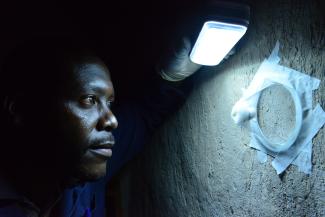OVERVIEW
USAID supports Kenya’s health sector with high-impact, evidence-based interventions. Most interventions in the health sector are at the county level. We work with the Government of Kenya, counties, local institutions, faith-based organizations, and the private sector on:
HIV/AIDS prevention and treatment
Malaria prevention and treatment
Tuberculosis (TB) control and treatment
Global health security
Reproductive, maternal, newborn, child, and adolescent health
Nutrition
Water, sanitation, and hygiene
By building the capacity of Kenyan institutions and individuals, USAID helps provide citizens and households with efficient, affordable, equitable, and quality health services. USAID is helping Kenya become stable, resilient, and prosperous.
PROGRAM AREAS
Strengthening Health Systems
USAID works with the Government of Kenya to build health systems that are responsive to the needs of individuals, families, and communities. USAID also supports improvements in the health workforce; health information systems; supply chain management; health financing; and leadership and governance. We have made significant investments to improve the supply chain management for HIV, malaria, and family planning initiatives. USAID also supports the Government of Kenya to improve the collection, verification, and use of health data.
Global Health Security
USAID’s Global Health Security program aims to strengthen the capacity of partner governments, universities, and research institutions; the private sector, and civil society for the prevention, preparedness, detection, and response to infectious disease threats. Recognizing the interconnection between the health of humans, animals, and their shared environment, USAID works across these sectors applying a one health approach to strengthen their health systems and achieve program objectives.
USAID has supported Kenya in establishing community-based surveillance for infectious diseases; zoonotic diseases surveillance and laboratory detection protocols. This approach coordinates mechanisms among ministries and other partners. USAID also responds to outbreaks in both humans and animals, including the 2018 and 2021 Rift Valley Fever outbreaks; 2019 anthrax outbreak, and COVID-19.
Controlling HIV Epidemic
USAID works through the President’s Emergency Plan for AIDS Relief (PEPFAR) to combat the HIV/AIDS epidemic. Launched in 2003, PEPFAR represents the largest U.S. Government investment in HIV globally. This initiative enables Kenyans living with HIV/AIDS to access treatment. PEPFAR also reduces the spread of HIV/AIDS from mother-to-child and partner-to-partner. As a result of U.S. Government efforts, more Kenyans are being tested for HIV and receiving life-saving antiretroviral therapy. HIV programming focuses on palliative care, orphans and vulnerable children, nutrition, home-based care, and other related services.
Reducing the Burden of Malaria
Malaria is one of the leading causes of sickness and death in Kenya. The U.S. President’s Malaria Initiative (PMI), a collaboration between the U.S. Government and Government of Kenya, expands malaria prevention and treatment measures. USAID procures and distributes malaria medicines to health facilities. USAID also provides insecticide-treated bed nets in communities and malaria prophylaxis to pregnant women. In addition, USAID supports indoor spraying to reduce the presence of malaria-carrying mosquitoes in homes.
Controlling Tuberculosis
TB remains the leading infectious disease killer globally. USAID strengthens Kenya’s National Tuberculosis and Lung Disease Program by improving diagnostics, increasing access to treatment, and combating drug-resistant TB and HIV-associated TB. USAID launched an initiative to leverage resources from countries, private-sector partners, and other local organizations. These resources will help Kenya meet the UN General Assembly's TB targets:
Treat 40 million people with TB by 2022
Start 30 million people on TB preventive therapy
Preventing Maternal and Child Deaths
Kenya has made great strides in reducing child deaths, with a nearly 30 percent decline in child and infant death between 2008 and 2014. Newborns and young children have a better chance to reach their full potential thanks to improvements in postnatal care. USAID continues to combat the main causes of maternal and child deaths. Work focuses on all aspects of service delivery systems, which includes:
Prenatal care
Skilled birth attendance
Essential newborn care
Postpartum care
Voluntary reproductive health services
Routine immunizations
Enhanced nutrition practices
Improved water, hygiene, and sanitation at the household level
FACT SHEETS
Overview: Health, Population and Nutrition
Preventing Maternal and Child Deaths
Reducing the Burden of Malaria
The U.S. President’s Malaria Initiative (PMI)
Activity Fact Sheets
HIV Prevention for Drugs Users
Kenya Health Partnerships for Quality Services
Risk Communications and Community Engagement for COVID-19
Tuberculosis Accelerated Response and Care
STORIES
Numbers Can Save Lives: Quality Data Helps Fight Malaria in Kenya
Going Above and Beyond To Fight HIV During Covid-19

Alex Kamweru for USAID
